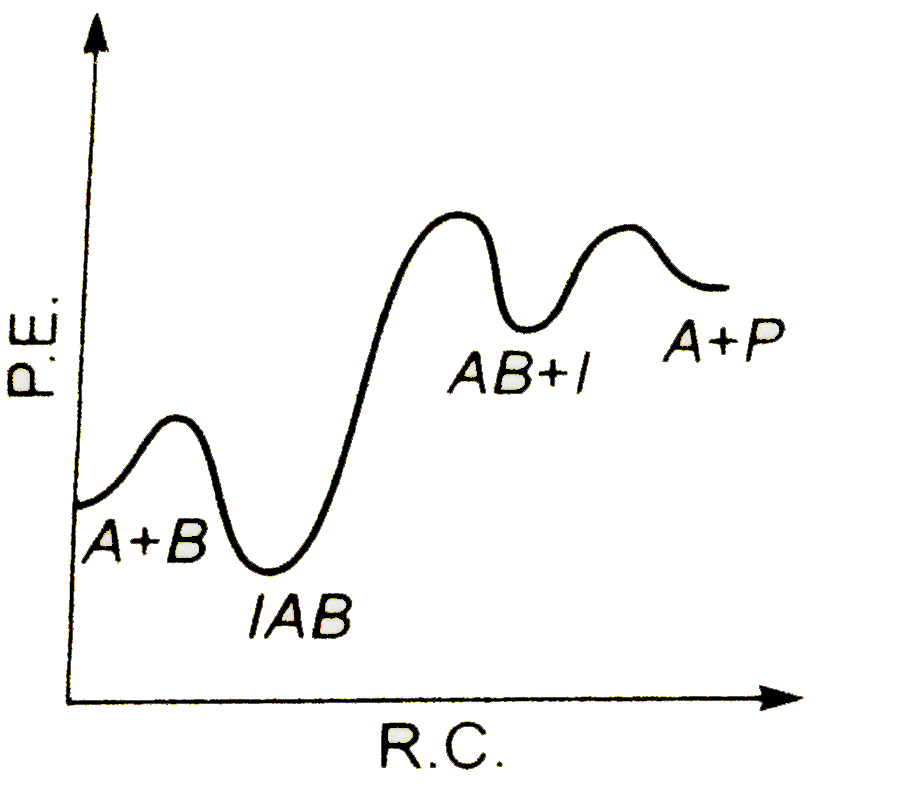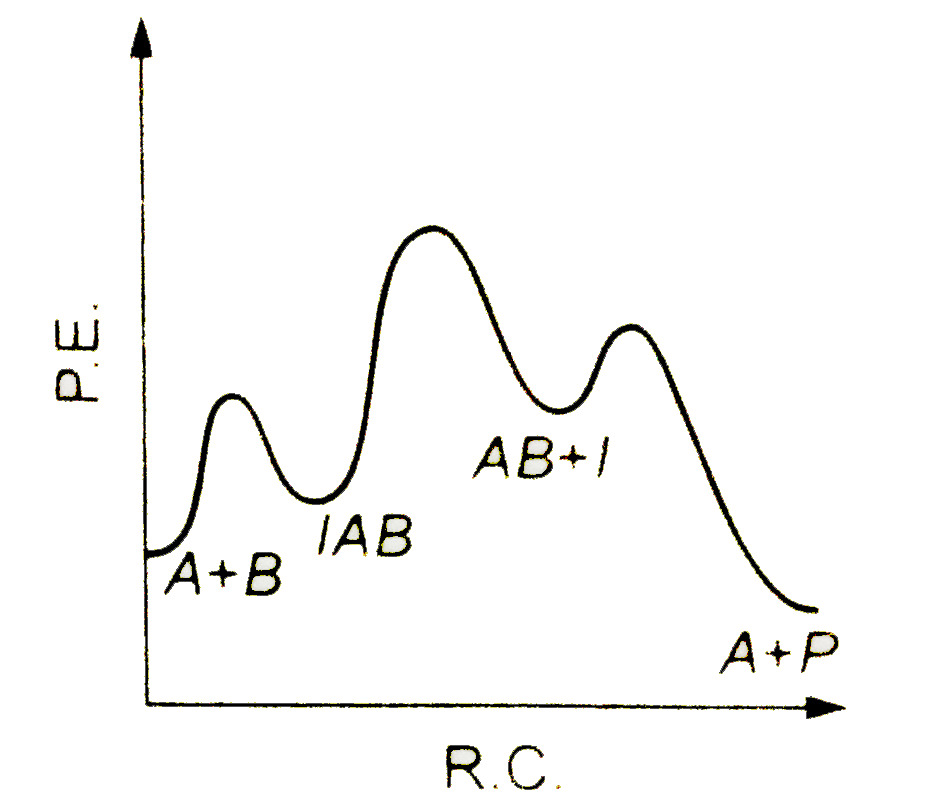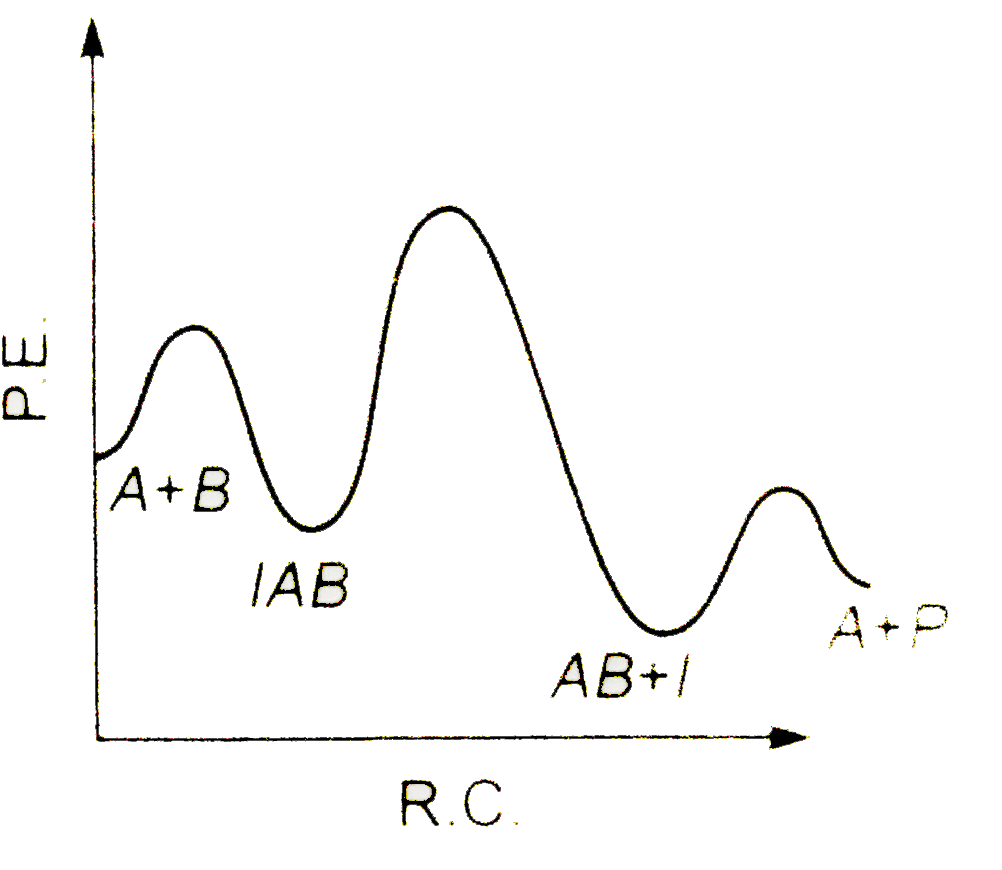The following mechanism has been proposed for the exothermic catalyzed cmplex reaction:
A+BFast−−→IABk1−−→AB+Ik2−−→P+A
If k1 is much smaller than k2, the most suitable qualitative plot of potential energy (PE) versus reaction coordinates for the above reaction is
a)  b)
b) 
c)  d)
d)  Solution in Punjabi
Solution in Punjabi




The correct Answer is:B
Step by step video & image solution for The following mechanism has been proposed for the exothermic catalyzed cmplex reaction: A + B overset("Fast")rarr IABoverset(k_(1))rarrAB+Ioverset(k_(2))rarrP+A If k_(1) is much smaller than k_(2), the most suitable qualitative plot of potential energy (PE) versus reaction coordinates for the above reaction is a) b) c) d) by Chemistry experts to help you in doubts & scoring excellent marks in Class 12 exams.
Topper's Solved these Questions
- BOOK - NARENDRA AWASTHICHAPTER - CHEMICAL KINETIC & NUCLEAR CHEMISTRYEXERCISE - Level 1 (Q.3 To Q.32)1videos
CHEMICAL KINETIC & NUCLEAR CHEMISTRY
- BOOK - NARENDRA AWASTHICHAPTER - CHEMICAL KINETIC & NUCLEAR CHEMISTRYEXERCISE - Level 1 (Q.33 To Q.62)2videos
CHEMICAL KINETIC & NUCLEAR CHEMISTRY
- BOOK - NARENDRA AWASTHICHAPTER - SURFACE CHEMISTRYEXERCISE - Level -21videos
SURFACE CHEMISTRY
Similar Questions
The following data pertain to reaction between A and B
S.No[A][B]RatemolL−1molL−1molL−1sec−1I1×10−22×10−22×10−4II2×10−22×10−24×10−4III2×10−24×10−28×10−4
Which of the following interference(s) can be drawn from the above data
(a) Rate constatnt of the reaction 10−4
(b) Rate law of reaction is k[A][B]
(c ) Rate of reaction increases four times on doubling the concentration of both the reactant Select the correct answer codes:
a) a,b and C
b) a and b
c) b and c
d) c alone01:13View Solutioncolumn Icolumn IIP.Zero order reaction1.t1/2α1[A]0Q.First order reaction2.t100%=[A]0/kR.second order reactions3.Involves at least two reactantsS.Pseudo unimolecular reaction4.[A]=[A]0e−kt
02:59View Solutionfor the graph below, select correct order of temperture ?
 06:51View Solution
06:51View SolutionMechanism of the reaction is:
Ak1−−→B,2Ak2−−→C+D
What is −d[A]dt ?01:48View SolutionConisder the following reactions:
I. A+Bk1⇐⇒k−1C
II. C+Bk2−−→D
Then k1[A][B]−k−1[C]−k2[C][B] is equal to01:21View SolutionThe following mechanism has been proposed for the exothermic catalyzed cmplex reaction:
A+BFast−−→IABk1−−→AB+Ik2−−→P+A
If k1 is much smaller than k2, the most suitable qualitative plot of potential energy (PE) versus reaction coordinates for the above reaction is02:41View SolutionA consecutive reaction, A overset(K_(1))(rarr)B overset(K_(2))(rarr)C is characterised by:
06:10View SolutionA hypothetical reaction : A_(2)+B_(2)rarr 2AB Follows mechanism as given below : A_(2) overset(k_(c))hArr A+A................( fast )" "(k_(C)- is equilibrium constant ) A+B_(2)overset(k_(1))rarrAB+B...............(" slow")" "(k_(1)- rate constant ) A+B underset(K_(2))overset(k_(2))hArrAB...............( fast )" "(k_(2),k_(3)- are rate constant ) Give the rate law.
04:23View SolutionFor the reactions
A⇔B,Kc=1
B⇔C,Kc=2
C⇔D,Kc=3
Kc for the reaction A⇔D is04:25View SolutionIn the following first order reactions (A)overset(k_(1))rarr"product",(B)overset(k_(2))rarr"product" , the ratio k_(1)//k_(2) if 90% of (A) has been reacted in time 't' while 99% of (B) has been reacted in time 2t is :
02:38View SolutionThe mechanism of the reaction A+2B rarr C+D is: Step I: A+B underset(k_(2))overset(k_(1))hArr I Step II: B+I overset(k_(3))rarr C+D In the first step is a fast equilibruim , then the incorrect statement is :
03:29View SolutionDecomposition of A to give B follows a two step mechansim as shown. From the mechanism identify the option which is incorrect. A rarr 1.5 B" " (overall reaction) Steps-1: A underset(k_(2))overset(k_(1))hArr B+C" " (fast) Step-2: A+C overset(k_(3))rarr 2B" " (slow)
03:13View SolutionThe reaction mechanism for the reaction PtoR is as follows: Punderset(k_(2))overset(k_(1))hArr2Q("fast"),2Q+poverset(k_(3))toR("slow") the rate law for the net reaction (ptoR) is:
02:52View SolutionIn the following first order competing reactions A overset(k_(1))rarr B, C overset(k_(2)) rarr D . If only 50% of A have been reacted whereas 94% of C has been reacted in the same time interval then find the ratio of (k_(2))/(k_(1)) .
02:00View Solution2A rarr B+C The mechanism of the above reaction given as 2A overset(K_(1))underset(K_(2))hArrX+2B (fast) X+B overset(K_(3))rarrC (slow) E_(1) = Activation energy for K_(1) K_(2) = Activation energy for K_(2) E_(3) =Activation energy for K_(3) Calculate E_("reaction") (given : E_(1) =10 kJ, E_(3)=5 kJ, E_(2) =12 kJ)
01:07View SolutionIn the sequence of reaction
AK1−−→BK2−−→CKc−−→D,K3>K2>K1 then the rate determining step of the reaction is03:13View Solution

